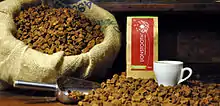Dandelion 'coffee' (also dandelion tea) is a tisane made from the root of the dandelion plant. The roasted dandelion root pieces and the beverage have some resemblance to coffee in appearance and taste, and it is thus commonly considered a coffee substitute. Dandelion root is used for both medicinal and culinary purposes and is thought to be a detoxifying herb.[1]
History
The usage of the dandelion plant dates back to the ancient Egyptians, Greeks and Romans. Additionally, for over a thousand years, Chinese traditional medicine has been known to incorporate the plant.[2]
Susanna Moodie explained how to prepare dandelion 'coffee' in her memoir of living in Canada, Roughing it in the Bush[3] (1852), where she mentions that she had heard of it from an article published in the 1830s in New York Albion by a certain Dr. Harrison. Dandelion 'coffee' was later mentioned in a Harpers New Monthly Magazine story in 1886.[4] In 1919, dandelion root was noted as a source of cheap 'coffee'.[5] It has also been part of edible plant classes dating back at least to the 1970s.[6]
Harvesting

Harvesting dandelion roots requires differentiating 'true' dandelions (Taraxacum spp.) from other yellow daisy-like flowers such as catsear and hawksbeard. True dandelions have a ground-level rosette of deep-toothed leaves and hollow straw-like stems. Large plants that are 3–4 years old, with taproots approximately 0.5 inch (13 mm) in diameter, are harvested for dandelion coffee. These taproots are similar in appearance to pale carrots.
Dandelion roots that are harvested in the spring have sweeter and less bitter notes, while fall-harvested roots are richer and more bitter.[7]
Preparation
The dandelion plant must be two years old before removing the root.[1] After harvesting, the dandelion roots are dried, chopped, and roasted. After harvesting, the dandelion roots are sliced lengthwise and placed to dry for two weeks in a warm area. When ready, the dried roots are oven-roasted and stored away. To prepare a cup, one will steep about 1 teaspoon of the root in hot water for around 10 minutes. Alternatively, packaged dandelion root coffee can be purchased. People often enjoy their dandelion coffee with cream and sugar.[8]

Health claims and uses
Although popular in alternative health circles, there is no empirical evidence that dandelion root or its extracts can treat any medical condition. In addition, very few high-quality clinical trials have been performed to investigate its effects.[9]
Health risks associated with dandelion root are uncommon; however, directly consuming the plant by mouth could lead to stomach discomfort, heartburn, allergic reactions, or diarrhea.[10]
Chemistry
Unroasted Taraxacum officinale (among other dandelion species) root contains:
- Taraxacin[11] (a guaianolide)
- Phenylpropanoid glycosides: dihydroconiferin, syringin, and dihydrosyringin
- Taraxacoside(a cylated gamma-butyrolactone glycoside)
- Lactupircin
- Apigenin-7-glucoside
- Luteolin-7-glucoside
- Isorhamnetin 3-glucoside
- Luteolin-7-diglucoside
- Quercetin-7-glucoside
- Quercetin
- Luteolin
- Rutin
- Chrysoeriol
- Caffeic acid
- Chlorogenic acid
- Chicoric acid (dicaffeoyltartaric acid)
- ρ-hydroxyphenylacetic acids
- Sesquiterpene lactones (of the germacranolide type)
- 11β, 13-dihydrolactucin
- Ixerin D
- Ainslioside taraxinic acid
- β-glucopyranosyl
- Taraxinic acid
- Glucosyl ester
- 11-dihydrotaraxinic acid and 13-dihydrotaraxinic acid
- l'-glucoside
- Lactucopicrin
- Lactucin
- Cichorin
- Eudesmanolides
- Tetrahydroridentin-B
- Taraxacolide-O-β-glucopyranoside
- Prunasin
- Dihydroconiferin
- Syringin
- Dihydrosyringin
- Taraxasterol
- ψ-taraxasterol
- Homo-taraxasterol
- Stigmatsterol
- Cycloartenol
- α-amyrin
- β-amyrin
- Arnidiol
- Faradiol
- Lupeol
- Taraxol
- Taraxaserol and
- 3β-hydroxylup-18-ene-21-one
- Taraxasterol
- ψ-taraxasterol
- Homo-taraxasterol
- β-sitosterol
- Stigmatsterol
- Campesterol
- Other
- Lettucenin A
- Taraxalisin, a serine proteinase
- Amino acids
- Choline
- Mucilage
- Pectin
See also
References
- 1 2 Chevallier, Andrew (2016). Encyclopedia of Herbal Medicine. New York: DK Publishing. p. 141. ISBN 9781465449818.
- ↑ "Ten Things You Might Not Know About Dandelions". Maine Organic Farmers and Gardeners. Retrieved 2021-02-04.
- ↑ Moodie, Susanna (4 December 2007). Roughing it in the bush. McClelland and Stewart. p. 385. ISBN 9780771034923. Retrieved 7 July 2011.
- ↑ Whiting, Julia D. (1886-09-01). "The End of a Love Match". Harpers New Monthly Magazine. Retrieved 2008-12-26.
{{cite journal}}: Cite journal requires|journal=(help) - ↑ "Much of the surpassing cheap brand coffee is made from dandelion root, according to Prof. William Trelease, of the department of botany at the University of Illinois." Jul 6, 1919 p. V13 Los Angeles Times
- ↑ Edible Wild Plants Class to Feature Dandelion Coffee Jun 16, 1977 p. CS8 Los Angeles Times Archived 2013-01-20 at the Wayback Machine
- ↑ Mars, Brigitte (1999). Dandelion Medicine. Storey Publishing. p. 64. ISBN 978-1580172073.
- ↑ Mars, Brigitte (1999). Dandelion Medicine. Storey Publishing. p. 189. ISBN 978-1580172073.
- ↑ "Dandelion". NCCIH. Retrieved 2022-12-21.
- ↑ "Doxycycline". Reactions Weekly. 1753 (1): 149. May 2019. doi:10.1007/s40278-019-62041-6. ISSN 0114-9954. S2CID 241943146.
- ↑ Ahmad, Viqar Uddin; Yasmeen, Shazia; Ali, Zulfiqar; Khan, Murad Ali; Choudhary, M. Iqbal; Akhtar, Farzana; Miana, Ghulam Abbas; Zahid, Muhammad (2000). "Taraxacin, a New Guaianolide from Taraxacum wallichii". Journal of Natural Products. 63 (7): 1010–1011. doi:10.1021/np990495+. ISSN 0163-3864. PMID 10924189.
